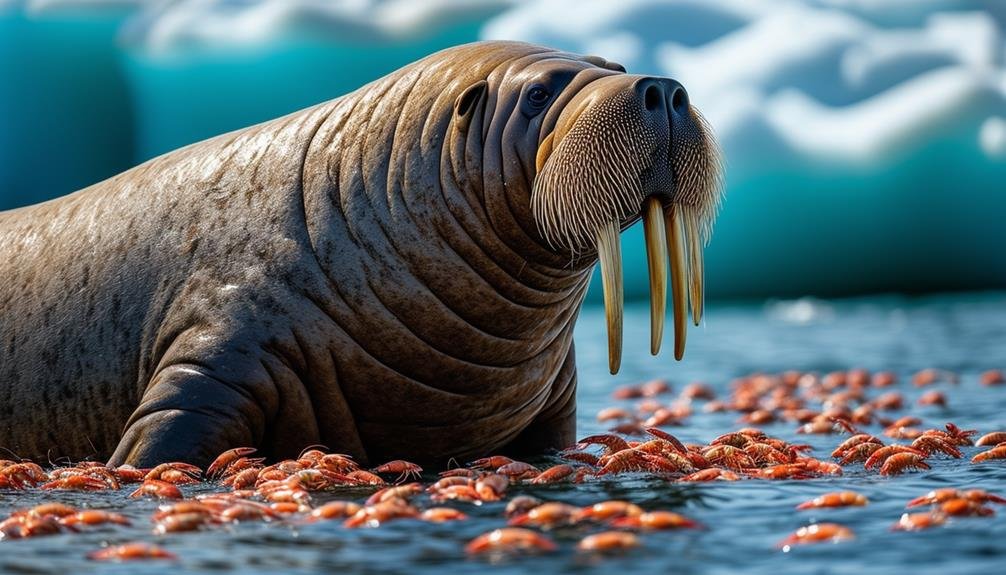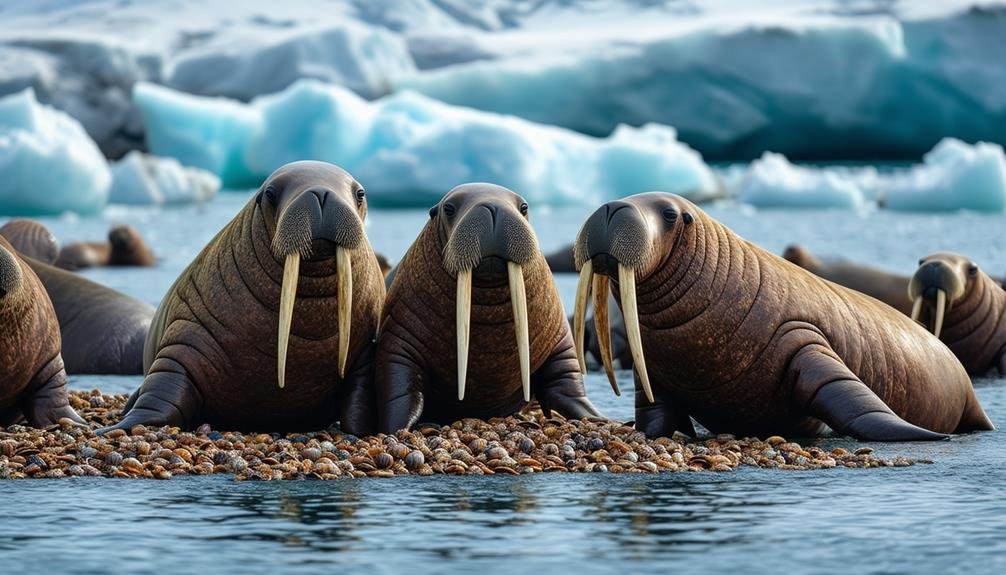Walruses thrive on a diverse diet that supports their nutritional health and adaptability. Key components include clams and mollusks, which are rich in protein and essential nutrients. Snails, shrimp, and crabs contribute crucial fatty acids necessary for blubber formation, while tube worms and soft corals provide additional vitamins and minerals. Seasonal diet changes ensure they receive varied nutrition, adapting to availability and environmental conditions. Moreover, group feeding enhances foraging efficiency and protection, and aids young walruses in learning critical survival skills. By understanding these dietary preferences, we can appreciate the complexities of walrus feeding behaviors in the wild. Learn more about this fascinating subject.
Main Points
- Clams and mollusks provide essential proteins, minerals, and fatty acids for muscle development and energy maintenance.
- Seasonal diet adaptations ensure walruses receive varied nutrients, aiding in ideal body condition and energy reserves.
- Soft corals offer crucial nutrients, especially during food scarcity, supporting overall walrus health amid climate change impacts.
- Group feeding enhances protection, foraging efficiency, and prey location sharing, fostering community survival.
- Tube worms are vital for essential nutrients and energy, contributing to the ecological balance and well-being of walrus populations.
Clams and Mollusks
Clams and mollusks play a cornerstone role in the walrus diet, providing essential nutrients and energy necessary for their survival in Arctic environments. As marine mammals, walruses heavily depend on these bivalves due to their abundance in the frigid waters of the Arctic. Clams and mollusks are not just plentiful; they are also packed with high protein content that is important for the growth and maintenance of walrus bodies. This protein is crucial for muscle development and overall health, helping these marine mammals to thrive in their harsh habitats.
Walruses utilize their highly sensitive whiskers, known as vibrissae, to locate and extract clams and mollusks from the ocean floor. These specialized whiskers allow them to detect even the slightest movements and textures, making it easier for them to find their food buried in the sediment. Additionally, the consumption of clams and mollusks aids in building up the necessary blubber layer that insulates walruses against the freezing Arctic temperatures. This blubber also serves as an important energy reserve, ensuring that walruses can endure periods when food is scarcer. Therefore, clams and mollusks are indispensable to the dietary needs of these marine mammals.
Snails
Snails form an important part of the walrus diet, offering essential proteins and minerals that contribute to their overall health and energy maintenance. These mollusks are not only a nutritious food source but also readily available in the walrus's natural habitats, such as the Arctic and sub-Arctic regions. The consumption of snails helps walruses maintain their energy levels and body condition, which is crucial for survival in their often harsh environments.
Walruses possess highly sensitive whiskers, or vibrissae, which they utilize to detect and capture snails on the ocean floor. This adaptation allows them to efficiently locate their prey even in murky waters or under ice cover. The ability to consume a variety of snail species further demonstrates the walrus's dietary adaptability, ensuring they can thrive despite seasonal or environmental changes that may affect the availability of other food sources.
Incorporating snails into their diet provides walruses with the necessary nutrients to support their large and energy-demanding bodies. Consequently, the presence of snails is essential for the sustenance and optimal health of walrus populations, emphasizing the importance of preserving their natural habitats for continued ecological balance.
Shrimp and Crabs

Shrimp and crabs play an essential role in a walrus's diet, offering important nutrients such as protein and minerals that support their substantial energy needs. The seasonal availability of these crustaceans greatly influences the foraging behavior and migration patterns of walruses, emphasizing their adaptability to changing food sources. By incorporating shrimp and crabs into their diet, walruses can maintain their large body size and thick blubber, which are crucial for survival in the frigid Arctic environment.
Nutritional Value Benefits
The inclusion of shrimp and crabs in the diet of walruses supplies necessary proteins and nutrients important for maintaining their energy levels and overall health. These marine organisms are rich sources of high-quality protein, which is essential for the growth and development of walrus calves. Additionally, the nutrients found in shrimp and crabs support various physiological functions, aiding in the overall well-being of walruses.
The high nutritional value of shrimp and crabs also plays a significant role in sustaining the large body size of adult walruses, which can weigh up to 1500 kg. The fatty acids present in these crustaceans are particularly beneficial, as they contribute to the development and maintenance of the thick blubber layer that walruses rely on for insulation in the frigid Arctic waters. This blubber layer is vital for thermoregulation and energy storage.
Key benefits of shrimp and crabs in walrus diets include:
- Protein and nutrient provision: Essential for energy, growth, and development.
- Support for blubber formation: Important for insulation and thermoregulation.
- Adaptability: Aids in thriving within their natural habitat despite changing food availability.
Thus, shrimp and crabs are indispensable to the dietary needs of walruses, ensuring their survival and adaptation in the wild.
Seasonal Availability Factors
Given the fluctuating conditions of Arctic waters, the seasonal availability of shrimp and crabs greatly influences the foraging behavior and nutritional intake of walruses. These prey items are essential components of the walrus diet, providing necessary nutrients and energy. In the Arctic ecosystem, shrimp and crabs are particularly abundant, aligning with the seasonal feeding patterns of walruses. The high protein content in these crustaceans supports the walruses' large body size and the maintenance of their thick blubber layer, which is crucial for insulation in cold environments.
Walruses rely on the seasonal availability of shrimp and crabs to sustain their health and energy levels. During periods when these prey are plentiful, walruses can build up their energy reserves, which is important for their overall well-being. However, changes in environmental conditions, such as temperature fluctuations and ice cover, can greatly affect the distribution and abundance of shrimp and crabs. Such variations in availability can impact the foraging success of walruses, posing challenges to their nutritional intake and overall health.
Understanding the seasonal dynamics of shrimp and crab populations within the Arctic ecosystem is crucial for comprehending the dietary patterns and ecological needs of walruses in the wild.
Tube Worms
Tube worms serve as an essential source of nutrition for walruses, providing necessary proteins and minerals that support their overall health. These marine worms, found in deep-sea environments, are a critical component of the walrus diet. Walruses have evolved to submerge into these underwater habitats to forage for tube worms, leveraging their specialized whiskers to detect and locate them on the ocean floor.
The nutritional benefits of tube worms for walruses are numerous:
- High Protein Content: Tube worms are rich in protein, which is vital for muscle maintenance and overall bodily functions.
- Mineral-Rich Diet: They provide essential minerals like iron and calcium, which are necessary for bone health and other physiological processes.
- Sustainable Resource: Tube worms reproduce rapidly, ensuring a steady and sustainable food source for walruses.
Consuming tube worms enables walruses to maintain their energy levels, which is particularly important given the energy demands of their cold-water habitats. This sustainable and nutrient-rich food source contributes significantly to the overall health and well-being of walruses in the wild, ensuring that they can thrive in their natural environments. By understanding the importance of tube worms in the walrus diet, we gain valuable insights into the ecological balance of marine ecosystems.
Soft Corals

Soft corals contribute important nutrients and dietary diversity to the walrus diet, particularly when other preferred food sources are scarce. Rich in protein and energy, these corals are crucial for the overall health and well-being of walruses. While they are not the primary component of the walrus diet, their consumption is essential during periods of food scarcity.
The table below summarizes key nutrients and benefits derived from soft corals:
| Nutrient | Benefit to Walruses |
|---|---|
| Protein | Important for muscle maintenance and energy |
| Vitamins | Supports immune function and overall health |
| Minerals | Contributes to bone health and metabolic functions |
| Energy | Provides calories necessary for survival |
Soft corals are also a significant source of vitamins and minerals, supplementing the walrus diet with essential nutrients that support their physiological functions are maintained. As climate change impacts the availability of traditional food sources, walruses may increasingly rely on soft corals for sustenance. The shifting environmental conditions underscore the importance of dietary adaptability in the wild.
Seasonal Diet Changes
Seasonal diet changes in walruses are driven by the availability and migration patterns of their primary food sources. These magnificent marine mammals adjust their diet to guarantee they meet their nutritional needs throughout the year. During warmer months, walruses primarily consume soft-bodied prey such as snails, which are more abundant and easier to access. Conversely, in colder months, their diet shifts to include more hard-shelled organisms like clams and mollusks, which offer a different nutritional profile.
The availability of food in different seasons influences the nutritional content of the walruses' diet, thereby supporting their growth and energy needs. Here are some key points to keep in mind:
- Nutritional Variation: Seasonal diet changes provide walruses with a varied intake of essential nutrients, which is important for maintaining their health.
- Body Condition: The shift in diet helps walruses maintain ideal body condition, essential for surviving harsh winter conditions.
- Conservation Efforts: Understanding these seasonal variations aids in conservation efforts, ensuring that walruses' food sources are protected year-round.
Group Feeding Benefits

Group feeding among walruses offers notable advantages, including enhanced protection against predators and improved foraging efficiency. By foraging in groups, walruses reduce the risk of predation, as the collective vigilance of the group helps detect and deter potential threats more effectively than solitary individuals. This cooperative behavior is particularly beneficial for young walruses, who gain protection and also acquire essential foraging skills by observing and imitating the adults.
Social feeding behavior is another key benefit of group feeding among walruses. The ability to share information about the location of prey allows these marine mammals to locate and access food sources more efficiently. When walruses forage together, they can coordinate their hunting efforts, notably enhancing their overall success rate in finding and consuming food. This cooperation is necessary for maintaining their energy levels and supporting their substantial dietary needs.
Moreover, the learning aspect of group feeding cannot be overstated. Young walruses benefit immensely from this dynamic, as they learn the intricacies of effective foraging techniques through direct observation and participation. In conclusion, group feeding is a crucial component of walrus survival in the wild, fostering both protection and efficient resource acquisition.
How Does Walrus Migration Affect Their Access to the Best Diets in the Wild?
Walrus migration plays a crucial role in ensuring these marine mammals have access to nutrient-rich feeding grounds. By following ice patterns and seasonal changes, walruses can reach areas abundant in clams, snails, and worms. One of the most fascinating **walrus migration facts** is how far they travel to maintain a balanced diet throughout the year.
Conclusion
To sum up, walruses in the wild have a diverse diet that includes clams, mollusks, snails, shrimp, crabs, tube worms, and soft corals. These food sources provide vital nutrients necessary for their survival and health. Seasonal changes influence their dietary patterns, while group feeding offers significant benefits, such as increased foraging efficiency and protection from predators. Understanding these dietary preferences and behaviors is essential for the conservation and study of walrus populations in their natural habitats.


